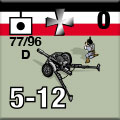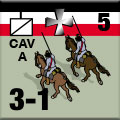| The Iron Dice of War:
Publisher’s Preview
By Mike Bennighof, Ph.D.
October 2024
 With August 1914 and Fall of Empires, we opened a game series called Infantry Attacks, based on tactical-level combat in the First World War. Units are infantry companies, cavalry squadrons and artillery batteries, activated by leaders to move toward the enemy and rallied by those same leaders when things go sideways. It’s a fairly easy game system to play, as wargames go, and it’s been pretty popular (again, as wargames go). With August 1914 and Fall of Empires, we opened a game series called Infantry Attacks, based on tactical-level combat in the First World War. Units are infantry companies, cavalry squadrons and artillery batteries, activated by leaders to move toward the enemy and rallied by those same leaders when things go sideways. It’s a fairly easy game system to play, as wargames go, and it’s been pretty popular (again, as wargames go).
Both August 1914 and Fall of Empires are set on the Eastern Front, built around the battles between the Germans and Austro-Hungarians, respectively, against the Russians. The Iron Dice of War takes the series to the Western Front, to the August 1914 Battle of the Ardennes.
On 4 August 1914, Germany declared war on Belgium and German armies immediately began crossing the border. They captured the fortress of Liège on 7 August, and the capital of Brussels on 20 August. All in accordance with pre-war planning, which was not nearly as precise as later writers made it out to be: the Germans sought a conclusive battle with the French somewhere in Belgium or norther France. And the French were determined to give it to them.
 France’s Plan XVII called for a strong counter-attack from the south against the open left flank of the Germans advancing into Belgium. The French accurately predicted that the Germans would use reserve formations in the front line (another cherished myth that does not hold up to scrutiny); where they went wrong was their assumption that the Germans would not insanely denude their eastern front of most forces and leave Berlin itself vulnerable to a Russian advance. France’s Plan XVII called for a strong counter-attack from the south against the open left flank of the Germans advancing into Belgium. The French accurately predicted that the Germans would use reserve formations in the front line (another cherished myth that does not hold up to scrutiny); where they went wrong was their assumption that the Germans would not insanely denude their eastern front of most forces and leave Berlin itself vulnerable to a Russian advance.
The French plan called for a strategic pause at the war’s beginning, until the Germans made their intentions clear. By the 20th, it had become obvious that the Germans had put most of their force on their right, in Belgium. French commander-in-chief Joseph Joffre ordered his Third and Fourth Armies to strike north-eastwards into the Ardennes, a region of rugged forests and hills on the border of Belgium and Germany. French pre-war analysis had predicted that German forces would be thin here.
This was not true.
 The German Fourth and Fifth Armies were on the march through the Ardennes with 380,000 men between them. When French reconnaissance made this clear, Joffre ordered the attack to press on. The oncoming German divisions crashed head-on into the two oncoming French armies, resulting in four days of ferocious fighting amid the farms, hills, and forests. German losses would total 48,000; the French lost 80,000. The German Fourth and Fifth Armies were on the march through the Ardennes with 380,000 men between them. When French reconnaissance made this clear, Joffre ordered the attack to press on. The oncoming German divisions crashed head-on into the two oncoming French armies, resulting in four days of ferocious fighting amid the farms, hills, and forests. German losses would total 48,000; the French lost 80,000.
That’s the background of The Iron Dice of War. It’s not a game of the entire battle; at 200 meters across each of the hexagons on the maps, and company-sized units, its scenarios instead focus on the key actions that made up the overall battle.
 In Infantry Attacks, players usually control roughly a brigade-sized force, three or four battalions (about a dozen companies, depending on their nationality) with supporting machine guns, field guns and at times cavalry, too. In addition to the combat units, they have leaders, who are the most important pieces in the game. In Infantry Attacks, players usually control roughly a brigade-sized force, three or four battalions (about a dozen companies, depending on their nationality) with supporting machine guns, field guns and at times cavalry, too. In addition to the combat units, they have leaders, who are the most important pieces in the game.
Both armies are at their peak morale at this moment, before they’ve been exposed to the horrific killing power of machine guns and most of all rapid-fire artillery. On the flip side of that, they’ve not learned the hard lessons of modern, industrial combat. To meet your objectives within the allotted time, you’re going to have to send your troops forward into that awful defensive fire; casualties are rarely a consideration. Thus, the players are having to use the tactics of 1914, without special rules forcing them to do so.
 Daily Content includes no AI-generated content or third-party ads. We work hard to keep it that way, and that’s a lot of work. You can help us keep things that way with your gift through this link right here. Daily Content includes no AI-generated content or third-party ads. We work hard to keep it that way, and that’s a lot of work. You can help us keep things that way with your gift through this link right here.
The French attack is spearheaded by the Colonial Corps, the toughest troops in the French Army with morale and leadership in par with anyone we’ve seen so far in Infantry Attacks: the Russian and Prussian Guard or the Austrian Kaiserjäger. The Colonials were Frenchmen, long-service volunteers who signed up for five-year terms in the French colonies. All of them had been under fire before, unlike the men of other armies’ elite formations, and even their reservists had combat experience in France’s wars of empire. The French regulars have superb morale, but not the same level of seasoning as the Colonials.
 What they do have (as do the Colonials) is Madame Soixante-Quinze, the famed French 75. The Model 1897 75mm field gun is the best such piece in the Infantry Attacks series, and will keep her crown through the entire war. That edge in direct support, though, is balanced by much better German longer-range heavy artillery (which is usually not present on the map). What they do have (as do the Colonials) is Madame Soixante-Quinze, the famed French 75. The Model 1897 75mm field gun is the best such piece in the Infantry Attacks series, and will keep her crown through the entire war. That edge in direct support, though, is balanced by much better German longer-range heavy artillery (which is usually not present on the map).
The Germans are also quite good at war. While their Reserve formations show up, and are not as good as the regulars, the third-line Landwehr formations seen in August 1914 are not present on the Western Front. The Germans are well-trained and exceptionally well led, with good heavy artillery support and a field gun that’s not nearly as good as the French model.
Neither side has had the opportunity to build elaborate trench lines; troops can dig in on the battlefield but this is still the period of maneuver on the Western Front. Both sides have good leadership, which means they can move pretty much at will, at least as much as the terrain allows. Both sides will have to both attack and defend.
 The Germans won the overall battle, though the French saw some success at the tactical level where The Iron Dice of War is focused. The usual explanation in facile popular histories is that the French attacked too aggressively, and that they wore red pants. The Germans won the overall battle, though the French saw some success at the tactical level where The Iron Dice of War is focused. The usual explanation in facile popular histories is that the French attacked too aggressively, and that they wore red pants.
The Iron Dice of War is built on deep research and analysis, because we want to not only give you a good game to play, but a tool you can use to explore what happened on the battlefields of August 1914. Both through the historical story woven through the scenarios, and the play of the scenarios themselves, you get to watch the story unfold on your game table.
Click here to join the Gold Club.
See your Gold Club Insider newsletter for ordering information.
Sign up for our newsletter right here. Your info will never be sold or transferred; we'll just use it to update you on new games and new offers.
Mike Bennighof is president of Avalanche Press and holds a doctorate in history from Emory University. A Fulbright Scholar and NASA Journalist in Space finalist, he has published a great many books, games and articles on historical subjects; people are saying that some of them are actually good.
He lives in Birmingham, Alabama with his wife, three children, and new puppy. He misses his lizard-hunting Iron Dog, Leopold.
Daily Content includes no AI-generated content or third-party ads. We work hard to keep it that way, and that’s a lot of work. You can help us keep things that way with your gift through this link right here.
|
